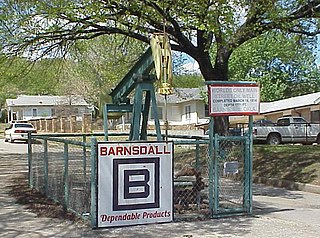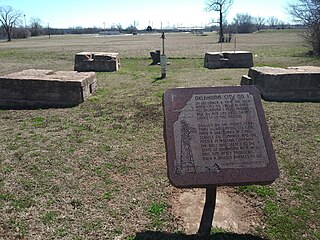 W
WThe Barnsdall Main Street Well is a formerly active oil well in the middle of Main Street in the town of Barnsdall, Oklahoma. It is believed to be the only such oil well anywhere in the world. It was listed on the National Register of Historic Places (NRHP) on October 1, 1997, as part of the "Energy Related Resources in Northeastern Oklahoma Multiple Property Submission". According to signage at the site, the well was completed on March 18, 1914, with a depth of 1771 feet. It remained active until the 1960s.
 W
WThe First Oil Well in Oklahoma was drilled in 1885 in Atoka County, Choctaw Nation, Indian Territory, though it was not completed until 1888.
 W
WLulu M. Hefner was a Cherokee businessperson from Nowata, Oklahoma who became successful in the oil industry. She was notable for being the first women to drill for oil on her own property and the first female oil operator in Oklahoma.
 W
WThe Jackson Barnett No. 11 Oil Well was the most productive oil well in the Cushing Oil Field of northeastern Oklahoma, USA, to the south of Drumright. The well was drilled in 1916 in the Shamrock Dome section of the Cushing field by the Gypsy Oil Company, striking oil on February 17. The well was on the land of Jackson Barnett, a Creek landowner who subsequently became known as the "world's richest Indian".
 W
WNellie Johnstone No. 1 was the first commercially productive oil well in Oklahoma. Completed on April 15, 1897, the well was drilled in the Bartlesville Sand near Bartlesville, opening an era of oil exploration and development in Oklahoma. It was abandoned as a well in 1964. The site was donated to the city of Bartlesville and is now a park, listed on the National Register of Historic Places, featuring a restored drilling rig.
 W
WThe Oklahoma City Discovery Well was the first successful oil well to be drilled in Oklahoma City, Oklahoma. The December 4, 1928 discovery opened the Oklahoma City Oil Field to extensive exploitation, creating an oil boom that sustained the area through the Great Depression. Because much of the oil was under the existing city, the Oklahoma City field pioneered the use of directional drilling to allow lateral displacement of well bores to reach deposits under developed areas.
 W
WThe R.E. Hoy No. 1 Oil Well was constructed by the Sinclair Oil & Refining Corporation in September 1916. It has been listed on the National Register of Historic Places since 1986. Milton C. Garber and his brother Bert Garber hired geologist Dorsey Hager to determine potential drilling locations on their properties. The Garber brothers contracted Harry F. Sinclair to construct a well on R. E. Hoy's farm. The well was drilled at a depth of 1,130–56 feet. At 4:00 AM on September 10, the oil began to flow, starting out at 90 to 100 barrels per day (16 m3/d). The Hoy sand was the first successful sand of the Garber-Covington oil field, and the first well to be drilled with the advice of a geologist. From 1916 to 1940 the well utilized primary production, adding secondary methods of gas injection and waterflooding. At the time of nomination, the Hoy well was producing 4 barrels per day (0.64 m3/d), and had been in operation for 69 years.
 W
WThe Wheeler No. 1 Oil Well was the first well drilled in the Drumright-Cushing Oil Field of northeast Oklahoma, near Drumright. The success of the well, drilled in 1912 by Thomas Baker Slick, Sr., led to the development of the Cushing field and gave impetus to the early development of Oklahoma oilfields. The Drumright-Cushing field would go on to produce 310,000 barrels of oil a day at its peak in May 1917. The well made Slick's name as "King of the Wildcatters".